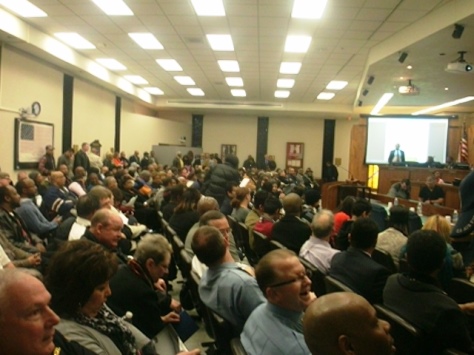
Photos by William Crum
There was an overflow crowd at the public safety diversity hearing Feb. 5 at City Hall in Kansas City, Kan.
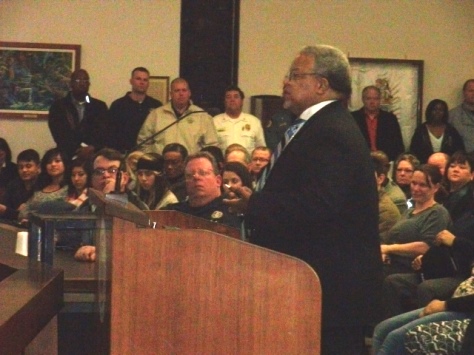
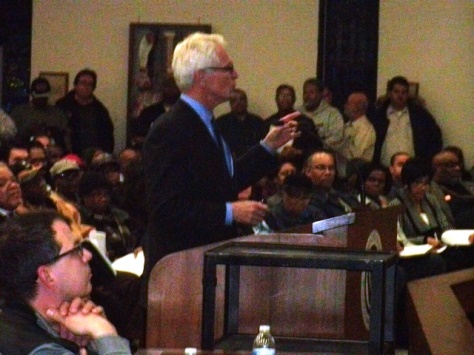
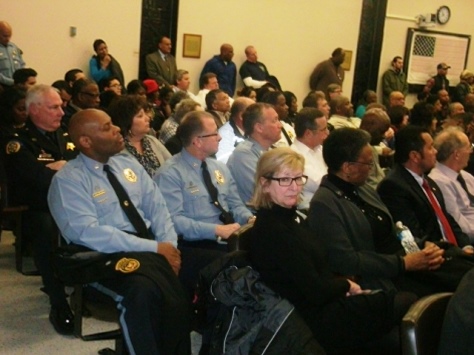
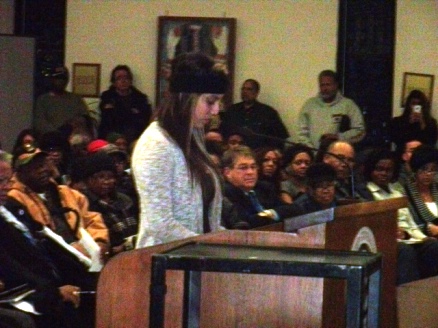
Serving Kansas City (Wyandotte County) Kansas for over 50 years!

Photos by William Crum
There was an overflow crowd at the public safety diversity hearing Feb. 5 at City Hall in Kansas City, Kan.




Thirty persons spoke out tonight about diversity in public safety positions at the Unified Government.
The public hearing at the UG Commission meeting tonight was standing-room-only. The diversity public hearing was an effort of Mayor Mark Holland and the Department of Justice.
The commission heard a variety of comments, from retirees who had worked in public safety positions, to residents, current employees, those who had been turned down for positions, and students who might be interested in future positions.
The mayor told the crowd that he started the process and appointed a task force to study it when he saw a Kansas City, Kan., Fire Department graduation in 2013 that consisted overwhelmingly of white males, and 75 percent of those were from other counties.
The Rev. Jimmie Banks leads the task force. In attendance at the meeting was U.S. Attorney Barry Grissom, who was supportive of the effort.
The mayor presented data that showed the population was 40 percent white, 27 percent black and 28 percent Hispanic, with 7 percent “other.” The non-public safety UG employees were 61 percent white, 25 percent black, 9 percent Hispanic and 5 percent other. The Sheriff’s Department employees were 66 percent white, 20 percent black, 8 percent Hispanic and 6 percent other. The Police Department employees were 72 percent white, 12 percent black, 11 percent Hispanic and 6 percent other. The Fire Department employees were 82 percent white, 7 percent black, 6 percent Hispanic and 4 percent other.
As for gender of employees, the population was 51 percent male and 49 percent female; the UG non-public safety employees were 51 percent male and 49 percent female; the Sheriff’s Department was 80 percent male and 20 percent female; the Police Department was 88 percent male and 12 percent female; and the Fire Department was 95 percent male and 5 percent female.
Several people related their personal experiences of passing all the written tests and classes, and said then they were told they would not be hired because of a three-minute psychological evaluation they were given.
“Something is seriously wrong and needs to be fixed,” said Jerome Randolph, a resident. He added they were losing qualified people to other cities.
Eric Copeland, who retired from the Fire Department, talked about the difficulties of being promoted, although he had good test scores and experience.
Tommy Wilson, who was a Fire Department employee, said the situation has not change since 1987 when he came on the job. “No one has addressed it,” he said.
PRIDE, the black firefighters’ organization, was represented at the meeting. Karen Jones, who is PRIDE’s representative on the task force, said PRIDE has tried to address this issue of diversity for years and felt that their concerns fell on deaf ears. She wanted to make sure that this is more than just talk and that changes are implemented and stay in place, and she offered to be part of an oversight committee.
Students from Wyandotte High School and from Bishop Ward High School also addressed the commissioners, saying that they would like more opportunities for internships, summer jobs, and job shadowing, with public agencies, that would open doors to jobs. The Junior Police Academy offered at the high school level was discussed.
The commission even heard from a pre-kindergarten student who said, “I wanted to be here because I want to be a fireman.”
Maria Kline said there has been a lot of talk in the past, but no solution. “The way to heal in our community, you have to see different races being a part of it,” she said.
Nancy Martinez said she believed that police officers and firefighters were being portrayed as monsters when they used to be portrayed as heroes, and she thought that was part of the problem of people not wanting to apply for the positions.
Terrance Henderson, president of the Kansas City, Kan., Black Firefighters Association PRIDE, said things have gone unchanged since the organization formed in 1978 to address issues of the lack of African-Americans being recruited and hired in fire service. He said PRIDE has been active in efforts to form partnerships, especially in the last year and a half, and that the public schools had a first responders program with the community college, in which high school seniors could participate.
“I received five emails about this hearing, and asked myself if this was some publicity stunt for reelection,” said Lamont Stewart. He said he hadn’t noticed any real changes since this effort was announced in January 2013.
Granville O’Neal, who served 32 years with the Fire Department, recommended a successful recruiting team, dropping the age to 19 for a greater pool of recruits, reviving the cadet program, re-establishing EMT certification in-house, seeking a federally mandated consent decree that would be in effect until department personnel are reflective of the community, creating an environment that promotes accountability, transparency and diversity, and eliminating positions based on nepotism, religious affiliation or patronage.
Mary Martin said, “To me, if it walks like a duck, looks like a duck, it is a duck. Therefore, we have massive discrimination in every level in Wyandotte.”
Even at the commission level, she said, it shows the seriousness and urgency of the issue. “Some of you all don’t care, and therefore we get the public policies we get,” she said. It is an interviewing problem, a hiring problem and a testing problem, she said. “I think it’s you all’s responsibility to take care of it.”
Cielo Fernandez, chief program officer at El Centro, talked about how some persons in the community did not trust people in uniform, and most people in uniform didn’t trust people who looked or talked like her. Instead of calling the police, some people come to her agency instead, she said. She said she looked forward to the task force and changing the public safety organizations to look more like the community they serve.
Brenda Shivers described past meetings with UG officials a few years ago to discuss increasing diversity on the public safety agencies. They also asked that the UG change the psychological test requirement, which was where some minority candidates were eliminated from hiring.
Delores Butler suggested re-establishing a career day in the public schools, so that children can meet firefighters and police officers.
Michelle D’Entremont, who was pursuing a career to be a firefighter paramedic, said she changed her mind when in the fire academy she was told that she would have to stop speaking out so much, not volunteer for tasks that require extra heavy lifting, and act “more female.” “Imagine how that sounds to me, an ex-Army officer who was one of only six females in a combat engineer company,” D’Entremont said. “I refuse to sit quietly in the little box assigned to my demographic.”
“You can’t just say you want more diversity, you need to exemplify it,” D’Entremont said. “The culture itself needs to change so that minority individuals feel included, wanted and valued for their skills and contributions, not excluded for their differences. If you truly want to find and retain talent from a broad pool of applicants, you need to make those applicants feel as though they won’t face a career-long uphill battle due to the very nature of their existence. Tell us that we have a place here, and then follow through.”
One speaker said it’s not just public safety agencies that need to change. Leroy Smith said, “Racism is running rampant in Kansas City, Kan.” In the eastern part of town, business places don’t have a restroom for the public to use, he said. But on the west side, they are available. “Something needs to change and it needs to change now,” he said.
Mike Vitale, a vice president of academics at Kansas City Kansas Community College, said about a year ago, the college’s EMT paramedic director immediately started a recruitment project working directly with high schools, speaking to students, bringing equipment and an ambulance for presentations. He also got firefighters involved. Now the program is allowing high school seniors to participate in some classes. The hiring age either has been lowered by the fire chief or is in the process, he added.
“While we heard a lot of very tragic and very disheartening and sad stories from a lot of people here tonight, we also heard a lot of positive things coming from the high school students,” Vitale said. “They’re still looking for that opportunity, they still have that belief that they can become the next fire chief, the next police chief and the next sheriff,” he said. “Let’s all keep working and make actions so those students’ dreams can come true. It may be too late for some but it’s not too late for the future.”
Murray D. Anderson Sr. said his definition of racism is “corrupt capitalism practiced by a municipal government or a state government or a federal government.” He told Mayor Holland that he had the power to change these circumstances and conditions immediately without waiting and without asking any of his colleagues, that the mayor-CEO’s power and authority is “totally concentrated.”
Morris Letcher, a 16-year veteran of the Fire Department and a captain, applied at the Police Department and was not hired, but then was hired by the Sheriff’s Department, and later went into the Fire Academy program. He is a coach at Piper High School.
He said, “In order to be a man you have to see a man. In order to be a fireman, you have to see a fireman. Our kids need to see what they want to become.”
As long as people keep talking and start implementing actions to progress, they can only get better, he said.
“Please don’t get mad. If we get mad, we’ll never go forward. We need to be steadfast, working out the problem, and press forward,” he said.
Mayor Holland said he intends to set up a program, and is not looking for a quick fix.
“We need a cultural institutional change, that will last for generations, and that will outlast me on this podium,” he said. A system is needed that will be carried forward by the people of the community, he said.
“We’re pushing ourselves down an irrevocable path, because when you say it in public, the public expectations go up, and the accountability goes up, and the public will not be denied,” Mayor Holland said. “We will be judged by the changes that we make, that are not short-term, that are not fast, but are long-lasting, so that in five years, in 10 years, in 20 years, we can look back tonight and say, we have made a difference.”
Tonight the Unified Government Commission heard at a special session that its credit rating had been downgraded by Moody’s.
David McGillivray, chairman of Springsted Public Finance Advisors, explained that Moody’s had downgraded the UG from Aa3 to A1 rating, while Standard and Poor’s had kept the UG’s bond rating at the same level, AA. Both were also listed as stable.
The discussion of the credit rating came on the same day that the UG has several issues of temporary notes and general obligation improvement bonds scheduled. Lew Levin, UG chief financial officer, stated the bond sales went well, and the UG received a good interest rate. Because of the low interest rates everywhere, the downgrade of the rating did not have as much of an effect as it otherwise might have had, according to the officials.
The downgrade from Moody’s is one notch lower than previously, and it is still a good rating, according to the financial advisers.
McGillivray explained that in 2011, Moody’s assigned the UG a rating with a negative outlook, that was sending signals that the UG needed to improve in certain areas, particularly in the fund balance.
He said the credit rating agencies place the most emphasis on the general fund balance and revenue diversification, and also put some emphasis on the community’s socioeconomics, including household income, tax base growth and stability, and population and development trends. The credit rating agencies expressed confidence in the UG’s governance and management, he said.
Moody’s considers Kansas governments’ dependence on sales tax revenues as somewhat fluctuating, and not as stable as the property tax, according to McGillivray.
In some ways, the Moody’s decision was driven by the UG’s fund balance, he added.
It was interesting, he said, that two agencies could look at the same government and come up with different conclusions.
Levin said he was hopeful that the UG will have a slight increase in the fund balance for the 2015 budget.
Mayor Mark Holland said the UG has already taken care of the fund balance problems and that Moody’s was looking at 2013 information, the last audited reports available, and the steps they took in 2014 and 2015 have not yet been reflected in those reports.
“For us to get through the recession with just a modest downgrade and retain the other is very positive,” Mayor Holland said.
He said the UG knew last summer that it was facing a downgrade and took aggressive action to deal with it.
“It’s not great news, but good news,” he said. “Because interest rates are so low, the penalty is not like anything it would have been in other years. We need to continue to protect that credit rating because it impacts us long term.”